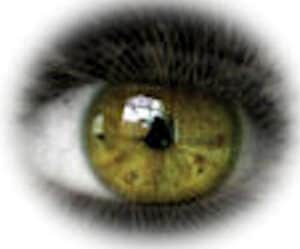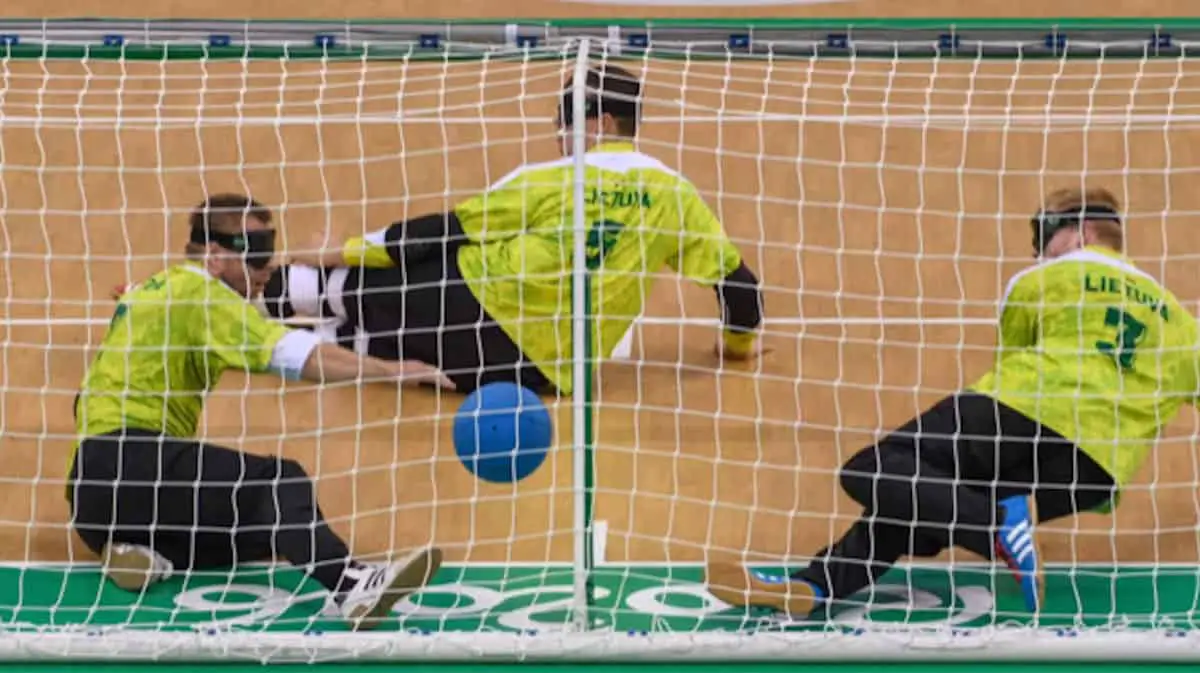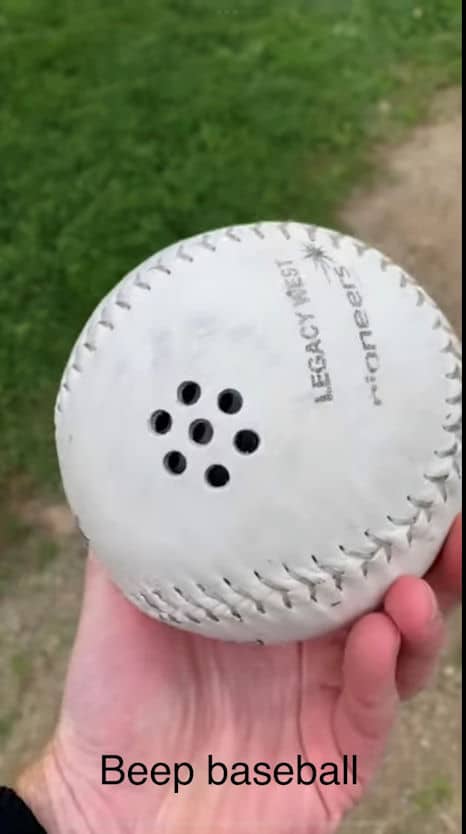Adaptive sports and activities refer to sports and recreational activities that are modified or adapted to accommodate individuals with disabilities, including those with visual impairments.
These modifications can range from equipment adjustments, such as using beeping balls or special rackets, to rule modifications that allow players to use their sense of touch to participate in the game.
For visually impaired children, adaptive sports and activities are especially important as they provide opportunities for physical activity, socialization, and skill development. Participating in adaptive sports and activities can help children with visual impairments build self-confidence, improve physical fitness, develop social skills, and enhance their overall quality of life.
According to the World Health Organization, approximately 7 million children under the age of 15 worldwide are visually impaired with severe vision impairments that may not be correctable with eyeglasses.
Studies have shown that children with visual impairments are less likely to engage in physical activity compared to their sighted peers. Lack of access to adaptive sports and activities, fear of injury, and a lack of social support are barriers to getting involved.
A lack of physical activity can lead to obesity, poor cardiovascular health, and reduced agility. It can also contribute to poor mental health and social isolation.
Learn more about: How Vision Loss Affects the Social, Emotional, and Practical Aspects of Life
The physical and mental health benefits of adaptive sports and activities for visually impaired children
By promoting inclusive environments and increasing access to adaptive sports and activities, we can help ensure that visually impaired children have the same opportunities for physical activity as their sighted peers.
- Improved Physical Fitness: Adaptive sports and activities promote physical activity, which can improve cardiovascular health, increase muscular strength and endurance, and enhance flexibility and balance.
- Increased Social Interaction: Participation in adaptive sports and activities can increase social interaction and foster a sense of community. It can also help children build friendships and develop social skills.
- Boosted Confidence and Self-esteem: Adaptive sports and activities can boost a child’s confidence and self-esteem. Through participation, children can feel a sense of achievement, develop a positive self-image, and gain a sense of purpose and meaning in life.
- Reduced Stress and Anxiety: Exercise is known to have stress-reducing effects, and adaptive sports and activities can help children manage stress and anxiety. It can also promote relaxation and improve mood.
- Enhanced Cognitive Function: Participating in adaptive sports and activities can enhance cognitive function by improving memory, attention, and executive function. It can also improve problem-solving skills and boost creativity.
- Improved Quality of Life: Adaptive sports and activities can improve the quality of life for visually impaired children. It can enhance physical health, mental well-being, and social connections, which can lead to a more fulfilling and enjoyable life.
Examples of adaptive sports and activities for visually impaired children
There are several adaptive sports and activities that are specifically designed for visually impaired children and adults. Examples include sports that are Paralympic sports:
Goalball: This is a sport specifically designed for visually impaired athletes. It is a popular Paralympic sport. The game involves two teams of three players each, and the objective is to throw a ball into the opposing team’s goal. The ball contains bells so that players can locate it through sound.
Learn more about goalball: International Paralympic Committee
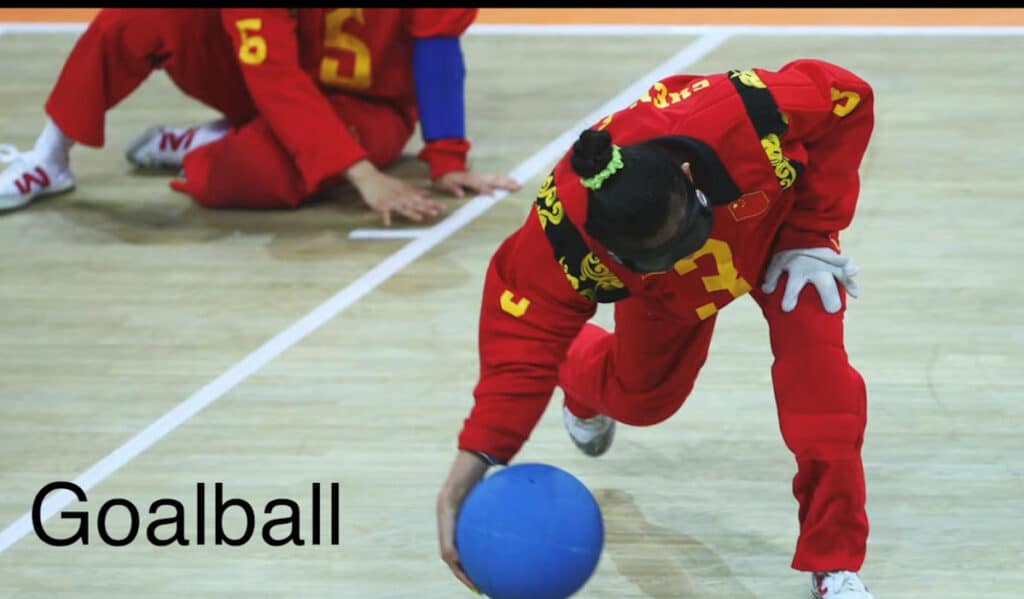
Beep baseball: This is a modified version of baseball that uses a ball that beeps to help players locate it. Bases also emit a beeping sound, and fielders use verbal cues to help guide their teammates.
Learn more: National Beep Baseball Association
Blind soccer (football): This is a modified version of soccer (football) that uses a ball with bells inside. There are only 4 field players and a goalie (5-a-side football). The goals are smaller, and the field is enclosed to keep the ball in play. This is also a Paralympic sport.
Learn more: GoalFix
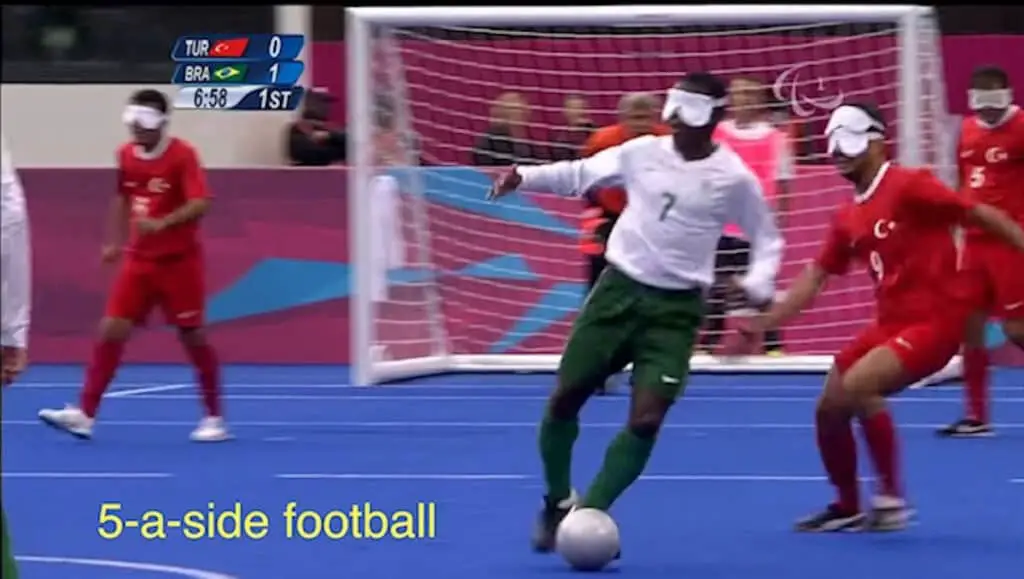
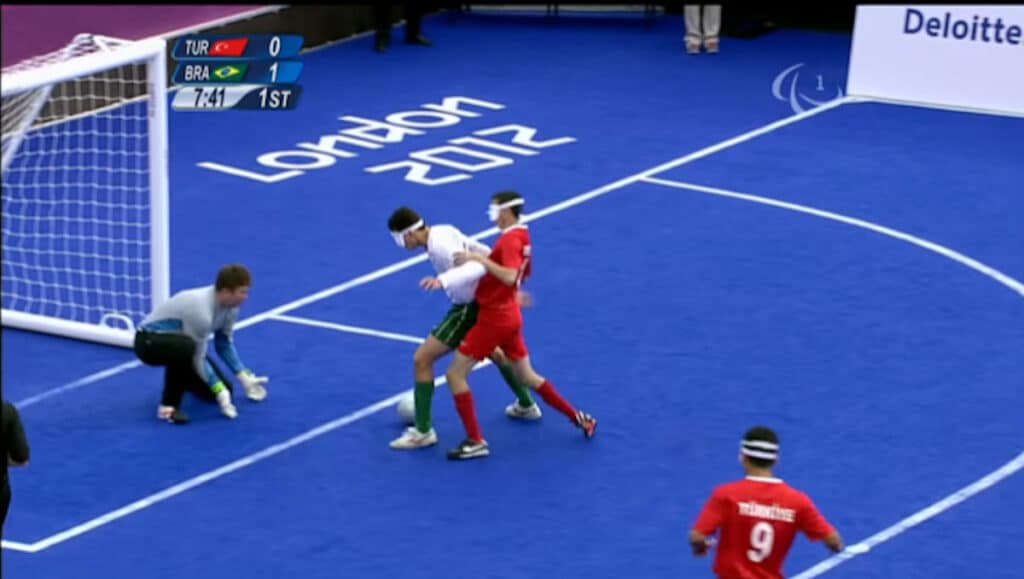
Judo: This is a martial art that emphasizes throws and grappling techniques, and it can be adapted for visually impaired athletes. The sport uses tactile cues and verbal commands to help competitors.
Learn more: International judo Federation
Rowing: This sport can be adapted for visually impaired athletes by using a coxswain to give verbal commands and guide the boat.
Learn more: Row Perfect
Swimming: This is a popular sport for visually impaired athletes, and can be adapted by using tactile markers at the end of each lane, and having a guide swimmer alongside the athlete.
Here are some tips for parents from Family Connect
Learn more: World Para Swimming
Skiing: Visually impaired athletes can participate in downhill and cross-country skiing using special equipment and guides to help them navigate the slopes.
Learn more: VisionAware.

Tandem cycling: This involves a visually impaired athlete riding a bicycle with a sighted guide in front. The guide provides verbal cues and helps to navigate the course.
Learn more: VisionAware
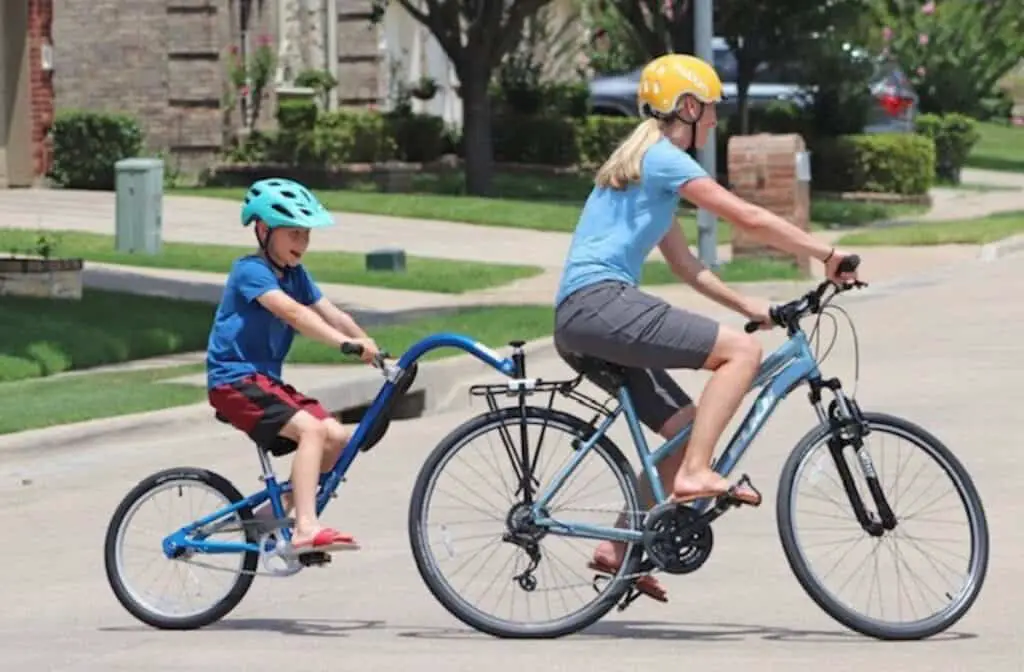
Track and Field: – there are a variety of adapted track and field events that visually impaired children can participate in, such as running and jumping events with the aid of a guide.
What can the parents do to help visually impaired children get involved in adaptive sports and activities?
Visually impaired children and their families can get involved in adaptive sports and activities through a variety of channels. Here are a few ways:
Contact local organizations: There are many organizations that provide resources and opportunities for visually impaired children to participate in adaptive sports and activities. These organizations often have programs and events that cater specifically to children with visual impairments. Examples of such organizations include the US Association of Blind Athletes, the National Beep Baseball Association, and the International Blind Sports Federation. * See resources at the end for a description of these organizations.
Reach out to schools: Many schools have adaptive physical education programs that provide opportunities for students with disabilities to participate in sports and other physical activities. Visually impaired children may be able to participate in these programs and receive specialized instruction from trained professionals.
Connect with community centers: Community centers often provide recreational programs that are accessible to individuals with disabilities. These programs may include adapted sports and other activities that are appropriate for visually impaired children.
Look for local events: Many communities host events and competitions for adaptive sports. Visually impaired children and their families can attend these events and get information about opportunities for participation.
Seek out adaptive sports equipment: Some sports require specialized equipment to accommodate visual impairments. Families may be able to purchase or borrow equipment through local organizations, schools, or community centers.
What are the challenges faced by visually impaired children participating in adaptive sports and activities?
Accessibility is one of the biggest challenges. Access to appropriate facilities and equipment can be a significant barrier for visually impaired children. Facilities may not be designed to accommodate visual impairments, and specialized equipment can be expensive or difficult to obtain. Specialized equipment and technology can help visually impaired children participate fully in sports and recreational activities.
Safety concerns: Safety is a concern for all athletes, but especially for the disabled. Coaches, trainers, and other participants may not be familiar with the needs and abilities of visually impaired children, which can increase the risk of accidents or injuries.
Coaches and trainers may need to provide additional instruction or support to ensure that visually impaired children can participate safely and effectively.
Social isolation is always a social concern for visually impaired children, but especially in activities such as sports and recreational activities. Because of fear or inexperience, they may lack the confidence to participate fully or feel excluded from certain activities.
Support networks can help visually impaired children overcome social isolation and emotional challenges related to their disability. Examples of support networks might include peer groups, mentors, and family members who can provide encouragement and emotional support.
Inclusion and accessibility are essential for ensuring that visually impaired children can participate fully in sports and recreational activities.
Communication barriers can prevent the visually impaired athlete from picking up sight cues during an activity. Teammates and coaches need to adapt their communication to utilizing distinct audio cues, like specific sounds or instructions. Establishing cues for communication between participants, and emphasizing collaboration and mutual support helps to break this barrier.
Emotional challenges: Visually impaired children may experience frustration, anxiety, and depression. These challenges can affect their ability to participate fully in sports and other activities.
Learning challenges: Coaches and trainers may need to provide additional instruction or support to ensure that these children can participate fully.
Training and coaching that are tailored to the needs of visually impaired children can help them develop the skills and confidence they need to participate fully in sports and recreational activities.
Sports and recreational activities can help visually impaired children develop important skills, such as teamwork, communication, and resilience.
Learn about the different types of vision loss, not all impairments are the same: What are the Types of Vision Loss
A few real-life success stories of visually impaired children who have gone on to have excelled in adaptive sports and activities
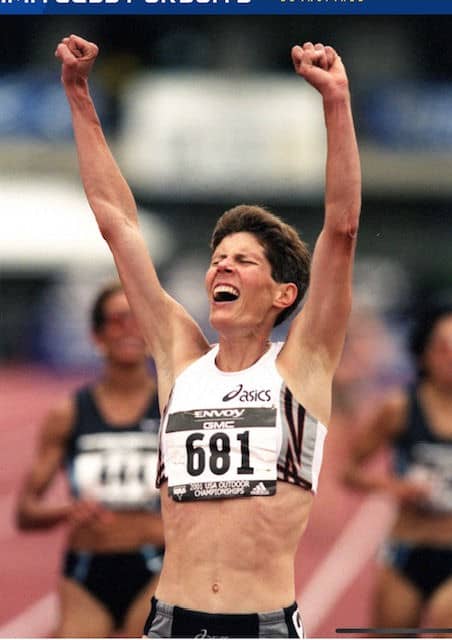
Marla Runyan is a track and field athlete, cyclist, and marathon runner who participated in the Paralympics, Olympics, and Pan American Games. She has won 5 gold metals and one silver in track and field Paralympics, and a gold in the Pan American Games. She was the first legally blind athlete to compete in the Olympics.
Lex Gillette is a blind Paralympic athlete who competes in the long jump. He has won four silver medals and one bronze medal in the Paralympic Games, as well as multiple world championships. Gillette credits sports with helping him build confidence and develop a positive attitude towards his disability.
Johannes Aigner is an Austrian para alpine skier, who is visually impaired. He won five medals, including two gold, two silvers, and a bronze medals at the 2022 Winter Paralympics.
Overall, these success stories demonstrate the profound impact that adaptive sports and activities can have on the lives of visually impaired children and can help visually impaired children develop the skills and confidence they need to succeed in all areas of life.
The Future of Adaptive Sports and Recreational Activities for Visually Impaired Children
Efforts should be focused on development of more personalized and tailored training and coaching programs for visually impaired children. By understanding the unique needs and challenges of each child, we can help create customized programs that optimize their growth and development.
Continued collaboration and knowledge-sharing among organizations, researchers, and practitioners in the field of adaptive sports and activities is key to making advances.
The future of adaptive sports and activities for visually impaired children promises new technologies, innovations, and programs on the horizon. These innovations can help break down barriers and create more opportunities for participation, engagement, and personal growth.
Wearable technology, assistive robotics, virtual reality, and artificial intelligence are all examples of technologies that can help visually impaired children (and adults) participate more fully in sports and activities, and we can expect to see continued growth and development in this area.
Outdoor athletes need to protect their eyes, learn more: How Sunglasses Can Help the Visually Impaired
For those interested in video game accessibility: How to Set Up Accessible Video Gaming for the Visually Impaired Gamer
In the End:
Adaptive sports and activities are crucial for visually impaired children as they provide opportunities for physical activity, socialization, and skill development. These activities help children build self-confidence and improve their overall quality of life. By creating inclusive environments and promoting participation in adaptive sports and activities, we can help visually impaired children lead fulfilling and active lives.
* Resources
There are many resources and organizations that offer adaptive sports and activities for individuals with visual impairments. Here are some examples: (not a complete list.)
United States Association of Blind Athletes (USABA): The USABA is a nonprofit organization that provides resources, opportunities, and support for visually impaired athletes of all ages and abilities. They offer a variety of sports programs, including goalball, track and field, swimming, skiing, and more.
(USABA): The USABA is a nonprofit organization that provides resources, opportunities, and support for visually impaired athletes of all ages and abilities. They offer a variety of sports programs, including goalball, track and field, swimming, skiing, and more.
International Blind Sports Federation (IBSA): The IBSA is an international organization that oversees and promotes sports for athletes with visual impairments. They organize world championships and other events in a variety of sports, including goalball, judo, powerlifting, and more.
(IBSA): The IBSA is an international organization that oversees and promotes sports for athletes with visual impairments. They organize world championships and other events in a variety of sports, including goalball, judo, powerlifting, and more.
National Federation of the Blind (NFB): The NFB is a nonprofit organization that advocates for the rights and needs of blind individuals. They provide resources and support for adaptive sports and other recreational activities, as well as education and employment opportunities.
(NFB): The NFB is a nonprofit organization that advocates for the rights and needs of blind individuals. They provide resources and support for adaptive sports and other recreational activities, as well as education and employment opportunities.
Disabled Sports USA (DSUSA): DSUSA is a nonprofit organization that provides adaptive sports opportunities for individuals with disabilities, including those with visual impairments. They offer programs in a variety of sports, including skiing, cycling, and rock climbing.
National Beep Baseball Association (NBBA): The NBBA is an organization that promotes beep baseball, a modified version of baseball designed for individuals with visual impairments. They provide resources and support for teams and players across the United States.
(NBBA): The NBBA is an organization that promotes beep baseball, a modified version of baseball designed for individuals with visual impairments. They provide resources and support for teams and players across the United States.
